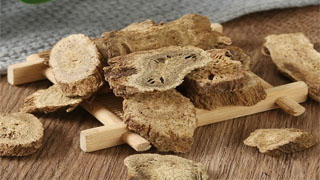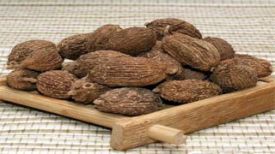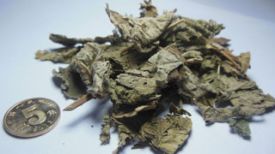
1. Alias
Honey fragrance, Qingmu fragrance, Wuxiang, Wumu fragrance, Nanmu fragrance, Guangmu fragrance.2. Plant morphology
Perennial tall herbaceous plant. The main root is cylindrical, with a diameter of up to 5 centimeters and a brown surface. The stem is sparsely covered with short hairs, and the basal leaves are large and have long stalks. The leaves are triangular ovate or long triangular, measuring 30-100 cm in length and 15-30 cm in width, with a heart-shaped base. The petiole usually extends into irregularly divided wing like shapes, with irregular shallow or microwave like edges, sparse short spines, and short hairs on both sides. The stem has smaller leaves, and the base of the leaves is wing shaped, extending downwards to embrace the stem. The inflorescence is apical and axillary, usually 2-3 clustered at the top of the stem. The diameter of the inflorescence is about 3 centimeters, with about 10 layers at the bracts. It is triangular lanceolate or elongated lanceolate, with the shortest outer layer. The flowers are all tubular, dark purple, with a 5-lobed corolla and 5 stamens. The inflorescence is clustered, and the ovary is lower. The style extends outside the corolla, and the stigma is bifurcated. The achene is linear, with a flowering period from May to August and a fruiting period from September to October.
3. Origin distribution
It is mainly cultivated in alpine areas and is native to India. Shaanxi, Gansu, Hubei, Hunan, Guangdong, Guangxi, Sichuan, Yunnan, Xizang, etc. in China are introduced and cultivated, mainly in Sichuan, Yunnan, and Hubei.
4. Harvesting and processing
Excavate in autumn and winter, remove sediment and fibrous roots, cut into sections, and then vertically slice the larger ones into petals. After drying, remove the coarse skin.
5. Characteristics of medicinal herbs
It is cylindrical or semi cylindrical in shape, measuring 5-10 centimeters in length and 0.5-5 centimeters in diameter. The surface is yellow brown to gray brown, with obvious wrinkles, longitudinal grooves, and lateral root marks. Solid in texture, not easy to break, with a gray brown to dark brown cross-section, gray yellow or light brown yellow edges, forming a layered brown ring, with radial texture and scattered brown dotted oil chambers. The aroma is unique and the taste is slightly bitter.
6. Sexual Taste Returning to the Classics
Warm in nature, spicy and bitter in taste. Guipi Meridian, Stomach Meridian, Large Intestine Meridian, Sanjiao Meridian, Gallbladder Meridian.
7. Effect and Function
Promote qi circulation and relieve pain, strengthen the spleen and digest food. It belongs to the category of Qi regulating medicine.
8. Clinical application
Oral administration: decoct soup, dosage 3-10 grams, or add pills or powder. External use: appropriate amount, mixed with grinding powder; Adjustment and application; Or apply ointment. Used for chest and abdominal distension and pain, severe diarrhea, persistent food accumulation, and lack of appetite. Boil wood incense to solidify the intestines and stop diarrhea. Used for diarrhea and abdominal pain.
9. Pharmacological research
It has the effects of promoting gastrointestinal peristalsis, dilating bronchial smooth muscle, antibacterial, hypoglycemic, anti-tumor, etc.
10. Chemical composition
The root oil mainly contains lignans, dehydrolignans, lignans, lignans, lignans, lignans acid, lignans alcohol, a-cyclolignans lactone, lignans lactone, β - sitosterol, eugenol, etc., with a content of up to 50%. Roots also contain 20 amino acids, including aspartic acid, glutamic acid, glycine, asparagine, palmitic acid, glutamic acid, glycine, asparagine, citrulline, gamma aminobutyric acid, etc.
11. Usage taboos
Those with dry and hot organs, yin deficiency, and insufficient body fluids should take it with caution.
12. Compatibility prescription
① Treat all qi disharmony and pain caused by walking and injection: Wood fragrance, grind with warm water to make it strong, and adjust with hot wine. (Simple and Convenient)
② Treatment of internal burning abdominal pain: 1.5g each of wood fragrance, frankincense, and myrrh. Boil it in water and take it. (Ruan's Prescriptions for Children)
③ Treating lung deficiency and persistent wheezing: 6 grams each of wood fragrance and self-defense, and 9 grams of almonds. Finally, refine honey pills, as big as beans. Take twenty pills each time, under mulberry white skin soup. If there is severe constipation, add a stalk. (Hygiene Easy Recipe)
④ Not suitable for treating sores: 6g of wood fragrance, 15g of Huangdan and dried alum each, and 3g of light powder. On top, each separately finely ground, mixed with pig bile, dried in the sun, and then finely ground. The affected area. (Shengji San in "Medical Standards")
⑤ Treating underarm odor: Soak good vinegar in wood fragrance and hold it under your armpit. (Essential Formula)
⊙ The content of the article is for clinical reference only. Non TCM professionals are not allowed to test drugs.


